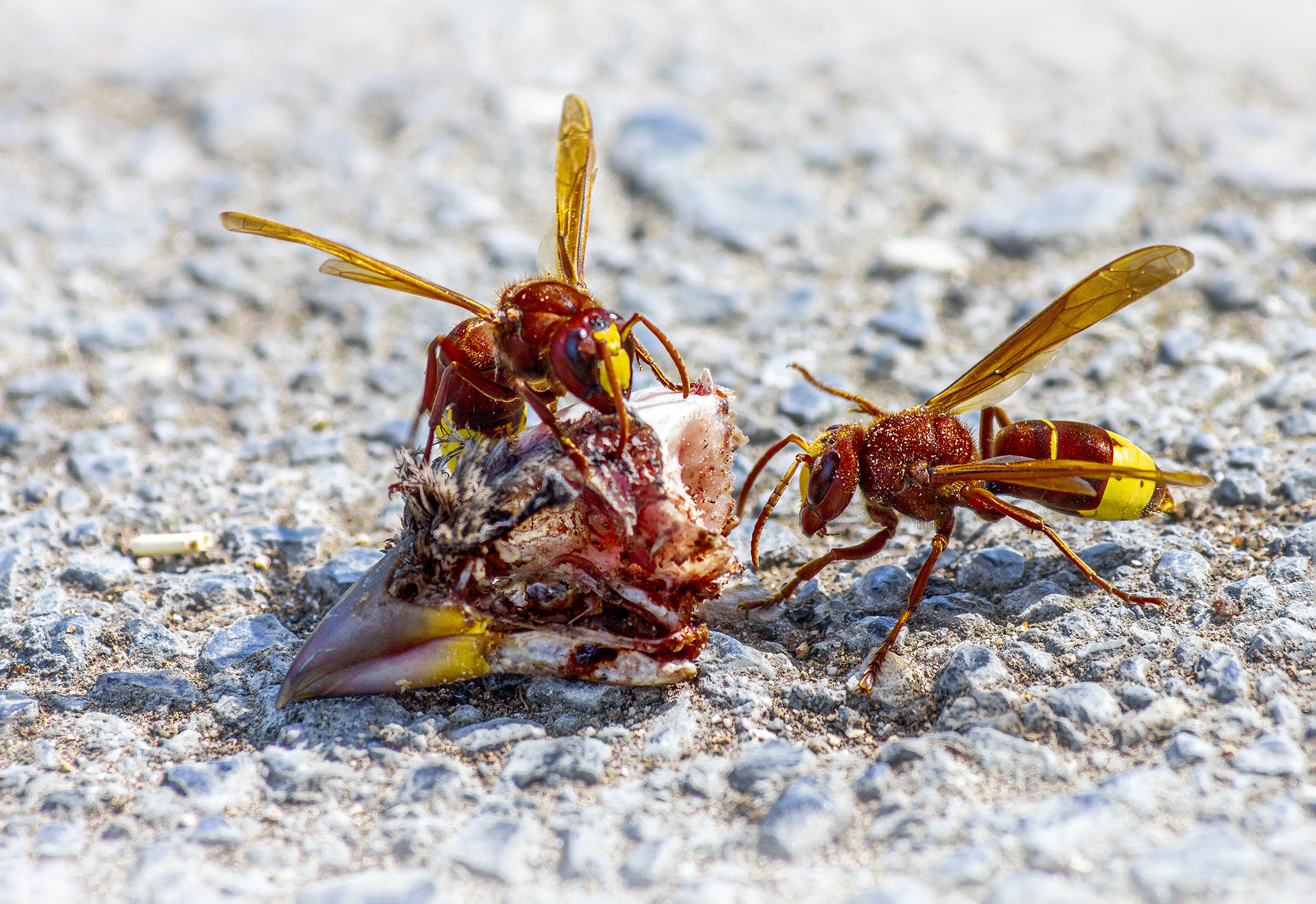The Oriental Hornet (Vespa orientalis) is a species of hornet that is native to parts of Europe, the Middle East, and Asia. Known for its striking appearance and aggressive behavior, this hornet plays a role in its ecosystem as both a predator and scavenger. Here’s a detailed overview of this fascinating insect:
Description
- Size:
- The Oriental Hornet is a medium to large hornet, with queens measuring about 25 to 30 millimeters in length, and workers around 15 to 20 millimeters.
- Appearance:
- Body Color: Vespa orientalis is characterized by its yellow and brown or reddish-brown coloration. The head and thorax are typically brown, while the abdomen has alternating yellow and brown bands.
- Wings: The wings are transparent with a brownish tint and can appear reddish-brown in certain lights. The wings are large and robust, aiding in both flight and hunting.
- Legs: The legs are yellow with brownish markings and are strong and bristly, adapted for both foraging and climbing.
- Antennae: The antennae are long and segmented, helping in navigation and sensing environmental cues.
Behavior and Ecology
- Habitat:
- Vespa orientalis prefers warm, temperate to tropical climates. It is commonly found in urban areas, gardens, parks, and open woodlands. The hornet builds its nests in a variety of locations, including underground burrows, wall cavities, and tree branches.
- Nesting:
- Nests: The nests are typically constructed from a papery substance created by chewing wood fibers mixed with saliva. The nests are usually round and can be quite large, often reaching up to 30 centimeters in diameter.
- Colony Structure: Colonies are founded by a single queen in the spring. The queen lays eggs, which hatch into larvae and then pupate into workers. Workers are responsible for foraging, nest maintenance, and care of the young. In late summer, new queens and males are produced, which mate and start new colonies the following year.
- Diet:
- Foraging: Vespa orientalis is an omnivorous predator and scavenger. It preys on other insects, including flies, bees, and wasps. Hornets are also known to scavenge on fruits, nectar, and human food.
- Feeding: The hornets use their strong mandibles to capture and kill prey. They inject venom with their sting, which can paralyze the prey. The hornets then chew up the prey and feed it to the larvae in the nest.
Lifecycle
- Eggs:
- The queen lays eggs in the early spring, which are initially cared for by the queen alone. The eggs develop into larvae, which are then fed by the queen.
- Larvae:
- The larvae are fed a diet of chewed-up insects and nectar. They go through several molts before pupating.
- Pupation:
- After the larval stage, the insects pupate within the nest. The pupal stage lasts several weeks, during which the larvae develop into adult hornets.
- Adults:
- The colony thrives during the summer months, with the queen, workers, and males all contributing to the colony’s activities. In late summer or early autumn, new queens and males are produced, which leave the nest to mate. The mated queens hibernate through the winter, while the rest of the colony dies off.
Ecological Role
- Predator:
- Vespa orientalis plays a significant role in controlling insect populations by preying on other insects. This predatory behavior helps maintain ecological balance.
- Pollination:
- While not as effective as bees, hornets do contribute to the pollination of plants as they forage for nectar.
Conservation Status
- Distribution:
- The Oriental Hornet is widespread across its native range, including parts of Europe, the Middle East, and Asia. It is not currently considered a threatened species.
- Impact:
- Vespa orientalis can become a nuisance in urban areas, where it may scavenge for food and build nests close to human activity. However, it is not typically aggressive towards humans unless provoked.
Summary
The Oriental Hornet (Vespa orientalis) is a striking insect known for its yellow and brown coloration and its role as a predator and scavenger. Found in warm climates, it builds nests in various locations and contributes to the ecological balance by controlling insect populations. Despite its potential to become a nuisance, the Oriental Hornet plays an important role in its ecosystem and is a fascinating example of the diversity of hornet species.efensive capabilities.
Views: 655
Subscribe to the newsletter:
